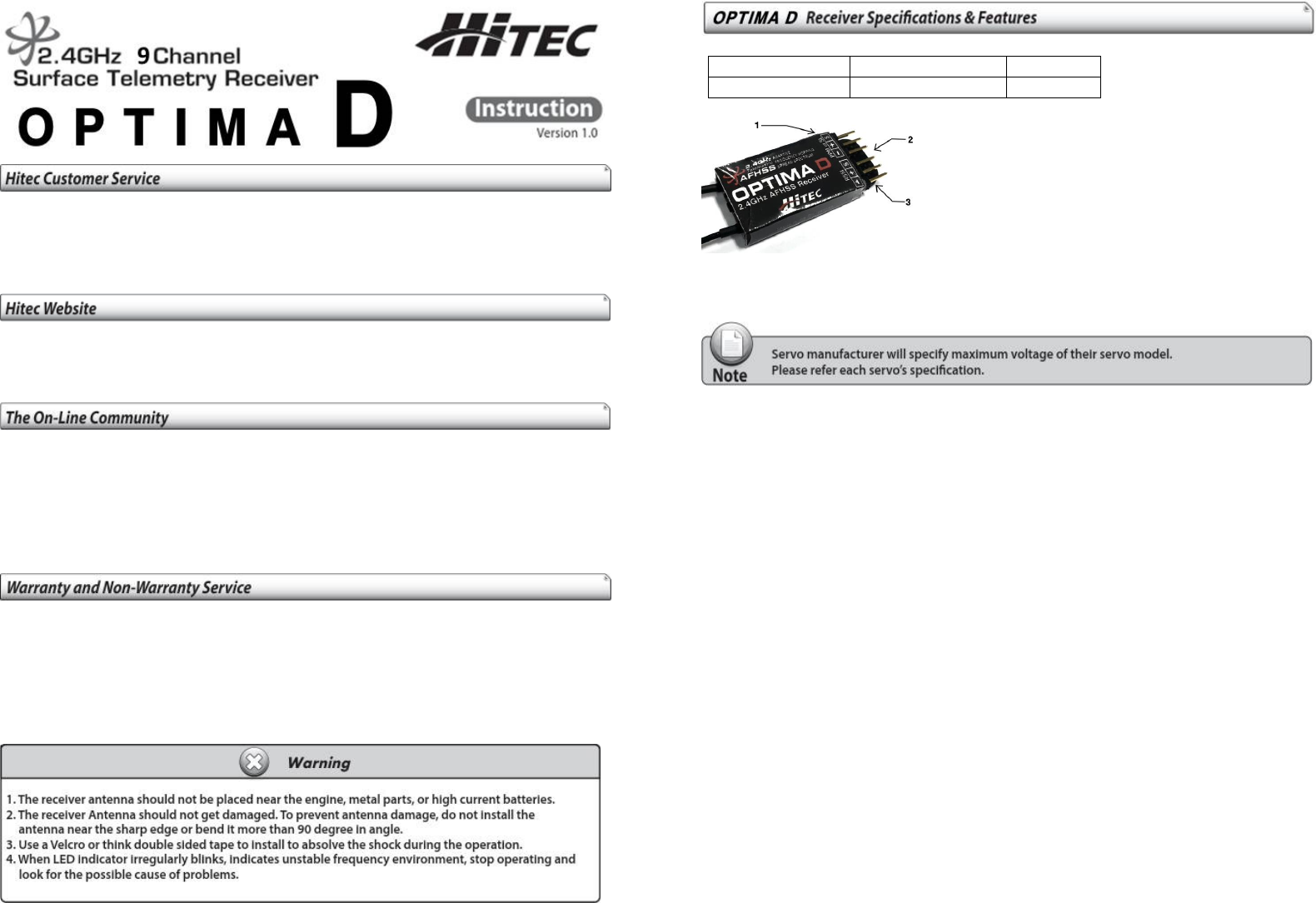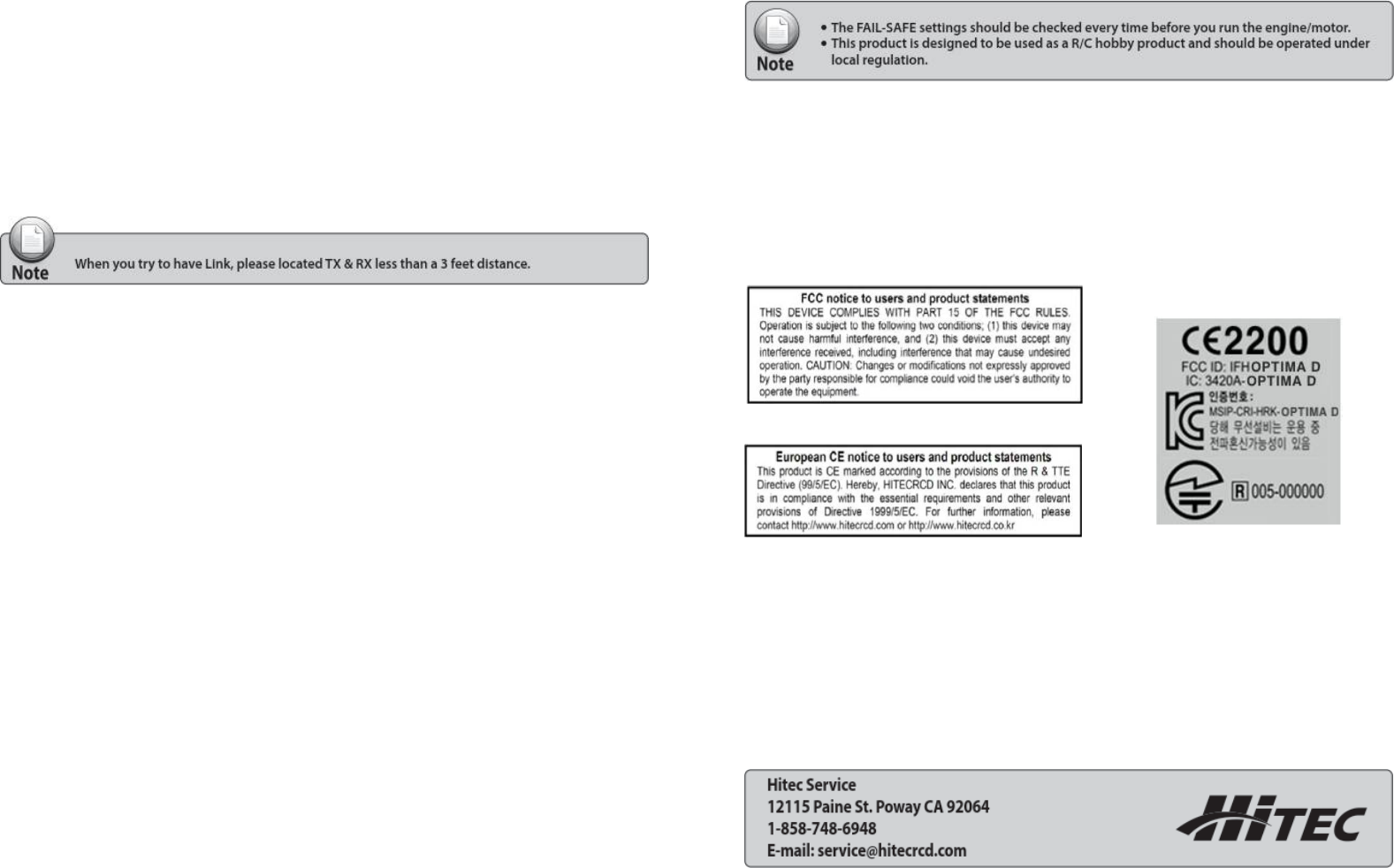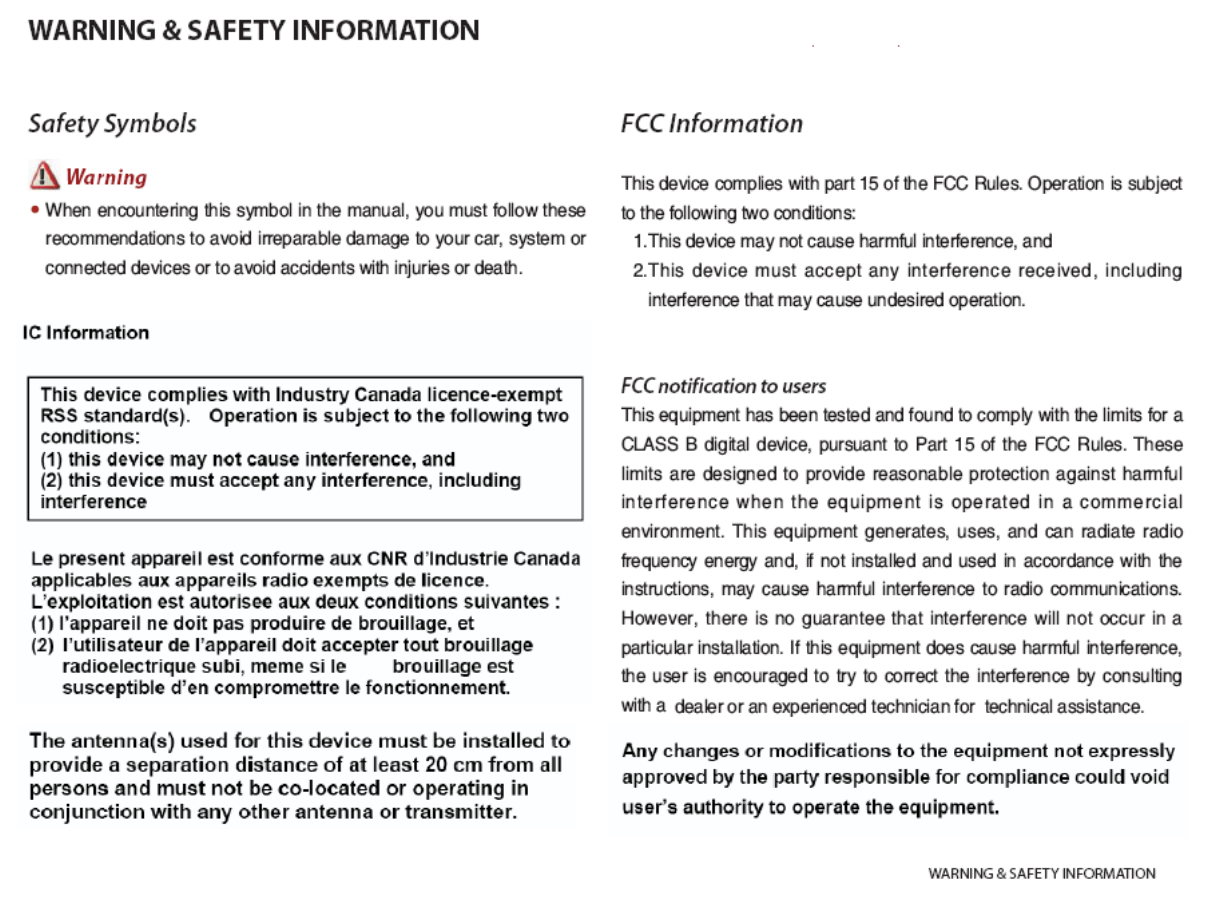Hitec RCD OPTIMAD 2.4GHz Aircraft Receiver User Manual
Hitec RCD Inc. 2.4GHz Aircraft Receiver
User Manual

Help is available from the Hitec office through phone support and e-mail inquiries.
Our US office is generally open Monday thru Friday, 8:00AM to 4:30PM PST.
These hours and days may vary by season. Every attempt is made to answer every incoming service call.
Should you get voice mail, leave your name and number and a staff member will return your call.
Make plans to visit the Hitec website, www.hitecrcd.com, on a regular basis. Not only is it full of specs and other
informaction about the entire Hitec product line, our FAQ pages will eventually hold valuable information and
program update about the OPTIMA D receiver.
One of the bene_ts of the extensive R/C online community is the vast wealth of archived knowledge available.
Hitec sponsors forums on most of the popular R/C web sites where a Hitec staff_ member or representative tries
to answer all manner of product related questions.
Bringing together strangers with common interests is proving to be one of the greatest gifts of the internet. If
past history is any guide to the future, we are certain forums will be started about the Hitec 2.4 system and
several are certain to stand out as valuable archives of information
All Hitec products carry a two year from date of purchase warranty against manufactures defects.
Our trained and professional service representative will determine if the item will be repaired or replaced. To
provide all the necessary information we need to administrate your repair, visit our website at www.hitecrcd.com
and download the repair form, _ll it out and send in your item for repair.
Receiver Model Size Weight
OPTIMA D 35 x 16.8 x 5mm 4.1g
1. LED
shows current status or set up status.
(See page 2 more details)
2. , PPM or S-BUS, RSSI signal output
PPM or S-BUS, RSSI output
3. Voltage Sensor input tap(Bottom)
Main power can be checked by this tap
Operation Voltage : 4.8V~7.2V (BEC from ESC can be used)
Voltage Sensor input tap
- User need to have soldering direct to here to check battery voltage (4.8V to 35V)
Bus System output
- Optima D provide PPM, S-Bus. But user must select one of signal type.
- (See page 2 more details)
RSSI Output
- Via RSSI, communication sensitivity can be seen through OSD.
Compatibility
- Optima D is using Hitec AFHSS 2.4GHz system, all Hitec radios can control Optima D Receiver.
How to Link (ID-Set)
When you purchase a radio set that Transmitter and receiver include together in the box, each device are linked
already from the factory.
If you purchase extra receivers or transmitter, you need to have Link with current your device together.
Aurora 9
Press and hold the button on the module, and turn on the transmitter*
For Aurora 9, once connect to module, press Link button in the module and turn on the transmitter. Press
Transmit “Yes” in the Aurora 9 screen and then release Link button.
1. Press Link button in the Receiver and turn on the Receiver. Once Receiver power is on, release Link

button. After release Link button, LED will turn Blue and entered Scan mode.
2. Once connection is completed, Red LED will be on in the module. After that BLUE LED will be blinking. At
the same time BLUE LED in the Receiver also will be blinking.
Now Connection is completed
3. Turn off and On both transmitter and receiver together, Beep sounds will be spoken 4 times. This sound
also shows that connection is completed.
Aurora 9X, Flash Series
1. Turn On the Transmitter.
2. Select ‘Spectra’ in the System menu of Transmitter.
3. Select RX type as “Opti&Mini”. Select ‘Binding’ and press ‘YES’.
4. Press Link button in the Receiver and turn on the Receiver. LED will turn Blue and entered Scan mode
5. Once Link is completed, Transmitter screen will be changed to the next step.
6. Turn Off/On the Receiver power and check the operation. Press ‘Finish’ on the radio to complete the Link.
Signal Mode Change ( PPM, S-Bus )
Optima D provides PPM and S-BUS signal. User can choice one of PPM or S-BUS according to their FC (Flight
Control).
1. Turn off the transmitter during this process
2. Press “Link” button of Optima D and turn on the Power.
3. Once BLUE LED is blinking and stop blinking, release Link button.
4. If BLUE LED is blinking 2 times- this is PPM Mode
If BLUE LED is blinking 3 times – this is S-BUS Mode
Once press Link, Mode will be changed.
5. Once signal mode is selected, press and hold Link Button about 3 seconds and release.
LED will be blinking rapidly. This is confirmation sign.
FAIL-SAFE and Hold Mode Setup
FAIL-SAFE point you previously stored in the FAIL-SAFE set-up. Make sure you set the FAIL-SAFE function
properly.
If FAIL-SAFE has not been activated, the signal will switch off after the HOLD period of one second. This means
that the servos become “soft” and remain in their last commanded position under no load (this may equate to
full-throttle!), until a valid signal is picked up again.
In the interest of safety, we recommend that the FAIL-SAFE function should always be activated, and the
FAIL-SAFE settings should be selected so as to bring the model to a non-critical situation (e.g. motor idle /
electric motor OFF, control surfaces neutral, airbrakes extended, aero-tow release open, etc.).
1. Turn On the transmitter and receiver
2. Check the correct operation and place control stick or control toggle of transmitter to fail-safe position.
3. Press and Hold Link button in the receiver in 6 seconds.
BLUE LED will be blinking start slowly and then blinking rapidly.
4. Once BLUE LED change to solid BLUE, Fail Safe is successfully completed.
5. Please turn off the transmitter to check the operation

Cet équipement doit être installé et utilisé avec un minimum de
20 cm de distance entre la source de rayonnement et votre
corps.